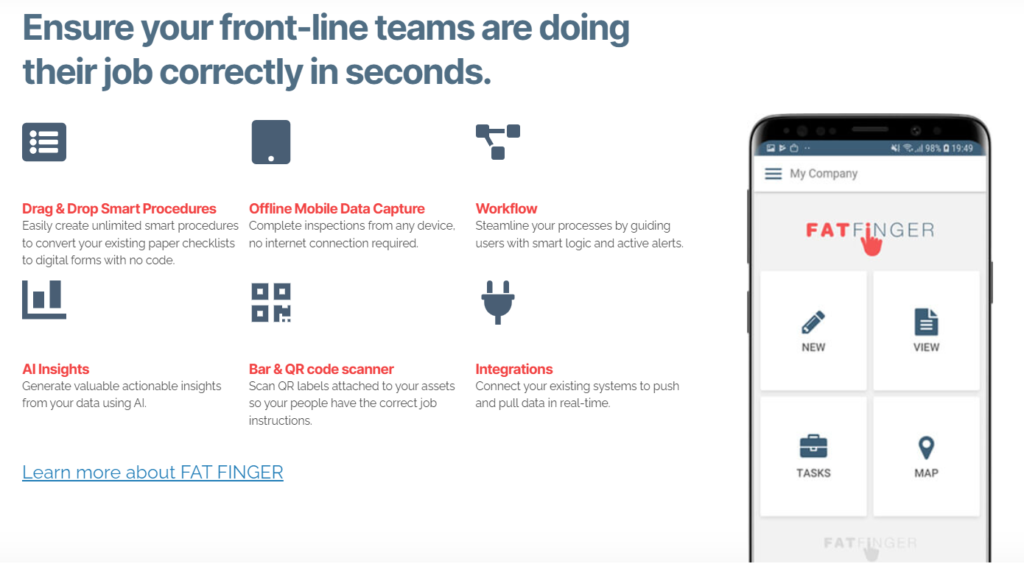In the digital age, the concept of the connected worker is rapidly gaining traction. This concept revolves around equipping workers with digital tools and technologies that enhance their productivity, safety, and efficiency. One company at the forefront of this revolution is FAT FINGER, a leading provider of digital workflow solutions. This article explores FAT FINGER’s vision for the connected worker in the digital age, highlighting how its innovative solutions are transforming the way businesses operate.
Understanding the Concept of the Connected Worker
Before delving into FAT FINGER’s vision, it’s crucial to understand what a connected worker is. In essence, a connected worker is an employee who leverages digital technologies to perform their tasks more efficiently and effectively. These technologies can range from wearable devices and mobile applications to cloud-based platforms and artificial intelligence.
- Wearable Devices: These include smart glasses, smartwatches, and other wearable tech that provide real-time information and insights to workers.
- Mobile Applications: Apps designed to streamline workflows, facilitate communication, and enhance productivity.
- Cloud-based Platforms: These platforms allow workers to access, share, and collaborate on documents and projects from anywhere, anytime.
- Artificial Intelligence: AI can automate routine tasks, provide predictive analytics, and support decision-making processes.
The Benefits of a Connected Workforce

There are numerous benefits associated with having a connected workforce. These include:
- Increased Productivity: Digital tools can automate routine tasks, freeing up workers to focus on more complex and value-adding activities.
- Improved Communication: Connected workers can communicate and collaborate more effectively, regardless of their physical location.
- Enhanced Safety: Wearable devices and IoT technologies can monitor workers’ health and safety in real-time, helping to prevent accidents and injuries.
- Better Decision-Making: Access to real-time data enables workers to make informed decisions, leading to improved outcomes and performance.
FAT FINGER’s Vision for the Connected Worker

FAT FINGER’s vision for the connected worker is centered on empowering employees with digital tools that simplify complex tasks, reduce errors, and boost productivity. The company’s innovative solutions are designed to digitize manual processes, facilitate real-time communication, and provide actionable insights that drive operational efficiency.
Digitizing Manual Processes
FAT FINGER’s digital workflow solutions are designed to replace paper-based processes with automated, digital workflows. For instance, its app allows workers to create, assign, and track tasks digitally, eliminating the need for paper forms and manual record-keeping. This not only saves time but also reduces the risk of errors and miscommunication.
Facilitating Real-Time Communication
Another key aspect of FAT FINGER’s vision is facilitating real-time communication among workers. Its solutions enable instant messaging, video conferencing, and real-time updates, ensuring that all team members are on the same page. This enhances collaboration, speeds up decision-making, and improves overall team productivity.
Providing Actionable Insights
FAT FINGER’s solutions also provide actionable insights that help businesses make informed decisions. By analyzing data from various sources, these solutions can identify trends, predict outcomes, and provide recommendations. This enables businesses to proactively address issues, optimize processes, and drive continuous improvement.
Case Study: How FAT FINGER Empowered a Connected Workforce
To illustrate FAT FINGER’s vision in action, consider the case of a global manufacturing company that implemented its solutions. The company was struggling with inefficient paper-based processes, poor communication, and a lack of actionable insights.
After implementing FAT FINGER’s solutions, the company was able to digitize its workflows, facilitate real-time communication, and gain actionable insights. As a result, it saw a significant improvement in productivity, a reduction in errors, and an increase in operational efficiency. This case study clearly demonstrates the transformative potential of FAT FINGER’s vision for the connected worker.
Challenges in Implementing a Connected Workforce
Despite the numerous benefits, there are also challenges that organizations need to overcome to successfully implement a connected workforce. These include:
- Privacy Concerns: The use of digital tools can raise privacy concerns, as they often involve the collection and storage of personal data.
- Technology Adoption: Not all workers may be comfortable using digital tools, and organizations may need to invest in training and support to ensure successful adoption.
- Infrastructure Requirements: Implementing a connected workforce requires a robust IT infrastructure, which can be costly and complex to set up and maintain.
Conclusion: The Future of the Connected Worker
In conclusion, FAT FINGER’s vision for the connected worker in the digital age is both compelling and transformative. By digitizing manual processes, facilitating real-time communication, and providing actionable insights, its solutions are empowering workers and revolutionizing the way businesses operate.
As digital technologies continue to evolve, the concept of the connected worker will only become more prevalent. FAT FINGER is leading the way, demonstrating how digital tools and technologies can enhance productivity, efficiency, and safety in the workplace. The future of work is connected, and FAT FINGER is at the forefront of this exciting revolution.


